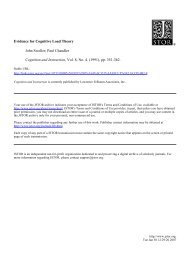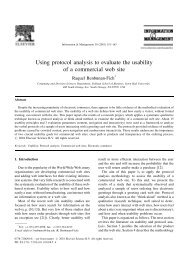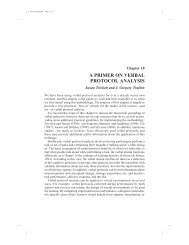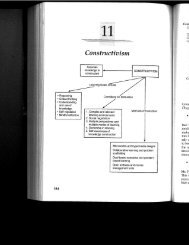Cognitive Theory of Inquiry Teaching-Collins - Ammon Wiemers ...
Cognitive Theory of Inquiry Teaching-Collins - Ammon Wiemers ...
Cognitive Theory of Inquiry Teaching-Collins - Ammon Wiemers ...
Create successful ePaper yourself
Turn your PDF publications into a flip-book with our unique Google optimized e-Paper software.
276 COLLINS AND STEVENSbug, he or she takes up the next highest priority bug, and attempts to fixSometimes when trying to fix one bug, the teacher diagnoses another bug. Ifnew bug is <strong>of</strong> a higher priority, the teacher sometimes interrupts the goal he oris pursuing to fix the higherpriority bug. Thus in the dialogues, there is apatterndiagnosing bugs at different times and holding them there until there is timecorrect them.CONCLUSIONThese techniques <strong>of</strong> inquiry teaching are designed to teach students torules and theories by dealing with specific cases,* and to apply these rulestheories to new cases. In this process the student is learning two kinds <strong>of</strong>t(l) specific theories about the knowledge domain; and (2) a variety <strong>of</strong>skills (see Table 8 .3) . In some sense the inquiry method models for the studenfprocess <strong>of</strong>being a scientist.The kinds <strong>of</strong> reasoning skills we think the student learns from this processforming hypotheses, testing hypotheses, making predictions, selecting optiÇases to test a theory, generating counterexamples and hypothetical cases, disguishing between necessary and sufficient conditions, considering alhypotheses, knowing the forms that rules and theories can take, knowingquestions to ask, and so on (see Table 8.4). In short, all the reasoning skillsscientists need arise in this model <strong>of</strong> teaching.Furthermore the technique is exceptionally motivating for students.**become involved in the process <strong>of</strong> creating new theories or recreating theorieshave been developed over centuries. It can be an exhilarating experience forstudents.In summary, by turning learning into problem solving, by carefully seleccases that optimize the abilities the teacher is trying to teach, by makinggrapple with counterexamples and entrapments, teachers challenge the studmore than by any other teaching method. The students come out <strong>of</strong> the experirable to attack novel problems by applying these strategies themselves.ACKNOWLEDGMENTSThis resea¡ch was sponsored by the Personnel and Training Researdr Programs,logical Sciences Division. Office <strong>of</strong> Naval Research under ContractNml4-79-C{338. Cont¡act Authority Identification Number NRI 54428.*Editor's note: This is what Landa refers to as discovery by ørnmplæ (w Ctrapta 6, p. 178),++Editor's note: See Chapter 11 for a description <strong>of</strong> some <strong>of</strong>the reasons why.8. A COGNITIVE THEORY OF INQUIRY TEACHING 277We thank Dean Russell Zwoyer <strong>of</strong> the School <strong>of</strong> Education at the Universitv <strong>of</strong> Illinois,ign-Urbana, for sending us transcripts <strong>of</strong> Pr<strong>of</strong>essor Max Beberman, Dr. IrvingI <strong>of</strong> the Educational Testing Service for sending us a tape and transcript <strong>of</strong> Eloise, Dr. Richard C. Anderson for sending us various tapes, transcripts, and otherls illustrating Socratic tutoring, and Natalie Dehn for recording Pr<strong>of</strong>essor Rogerduring one <strong>of</strong>his classes at Yale.REFERENCES,R. P. Differences between belief and knowledge systems. <strong>Cognitive</strong> Science, 19'79, 3,385.R. C., & Faust, G. \N . Educational psychology : The science <strong>of</strong> instruction and learning.'.ÌNêw York: Dodd, Mead, 1974n,J.S.,&Burton,R.R. Diagnosticmodelsforproceduralbugsinbasicmathematicalskillsit:<strong>Cognitive</strong> S c ie nce, 197 8, 2, | 55 - 192, W. G., & Simon, H. A. The mind's eye in chess. In W. G. Chase (Ed.), Visual informationprocessing. New York: Academic Press, 1973., A. Processes in acquiring knowledge. In R. C. Anderson, R. J. Spiro, & W. E. Montague' @ds.), Schooling and the acquisition <strong>of</strong> knowledg¿. Hillsdale, N.J.: Lawrence Erlbaum Associates,ins, A. Explicating the tacit knowledge in teaching and learning. Paper presented at AmericantEducational Research Association, Toronto, I 9784., & Stevens, A. L. Goals and srategies <strong>of</strong> effective teachers. In R. Glaser (EÀ.), Advancesilin instructiorul psychologlt (Vol. 2). Flillsdale, N.J.: l¿wrence Erlbaum Associates, 1982.ins, 4., Wamock, E. H., Aiello, N., & Miller, M. L. Reasoning from incomplete knowledge.In D. Bobrow & A. <strong>Collins</strong> (F,ds.), Representation and understanding: Studies in cognitive'3c¡enc¿. New York: Academic Press. 1975ins,4., Wamock, E. H., & Passafiume, J. J. Analysis and synthesis <strong>of</strong> tutorial dialogues. In'lG. H. Bower (Ed.), The psychology <strong>of</strong> learning and motivation (Vol. 9). New York: Academic,R.B. Discoveryintheteaching<strong>of</strong>mathematics. InL.S.Shulman&E.R.Keisler(Eds.),'''Learning by discovery: A critical appraisal. Chicago: Rand McNally, 1966ig, W., Munter, P., Swets, J., & Breen, M. Computer-aided teaching in medical diagnosisJ.ournal <strong>of</strong> Medical Education. 1964. 3 9.'7 46-'7 55.in, J. Information processing models and science instruction. In J. Lochhead & J. Clement (Eds.),.<strong>Cognitive</strong>processinstruction. Philadelphia:TheFranklinlnstitutePress,1979, A. Sentencing. Shown on Miller's Cour\, WCVB, Boston on October 12, 1979.4., & Simon, H. A.. Human problerh solving. EnSewood Cliffs, N.J.: Prentice-Hall,Lachés, Protagoras, Meno, and Euthydemusaward University Press, 1924.; I. E., & Saunders, R. An inquiry into inquiry: Question-asking as an instructional model. InKatz (Ed. ), Current topics in early childhood education. Norwood, N. J. : Ablex, 1979.;D.P.,&Simon,H.A.,Atale<strong>of</strong>twoprotocols. InJ.Lochhead&J.Clement(Eds.),<strong>Cognitive</strong>instruction. Philadelphia: The Franklin Institute Press, 1979.,4.L.,&<strong>Collins</strong>,A. Thegoal structure<strong>of</strong>aSocraticfutor.Proceedings<strong>of</strong>AssociationforQòmputing M achinery National C onference,Seattle, Washington, |9'17A. L., & <strong>Collins</strong>, A. Multiple conceptual models <strong>of</strong> a complex system. In R. Snow,Federico, & W. Montague (Eds.), Aptitude, learning, and instruction: <strong>Cognitive</strong> process. Hillsdale, N.J.: Lawrence Erlbaum Associates, 1980.






